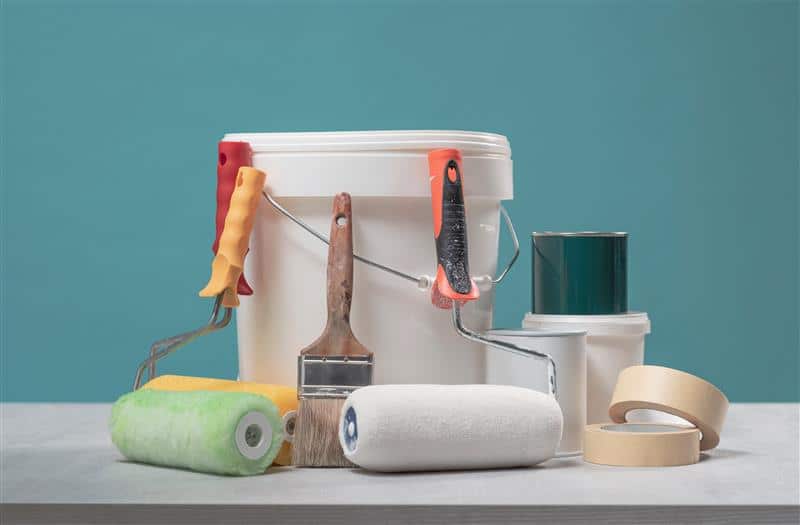
To successfully complete painting jobs, you need more than a few cans of paint and a brush or two. Every painting business, regardless of its target market, needs basic tools and equipment to provide the highest-quality results. But what equipment do you need to start a painting business?
It’s true that some specialized projects may require more sophisticated equipment, such as a specific type of coating, finish, or primer. Conversely, it’s likely you won’t use everything on your painting equipment list for every job, but it’s crucial to be prepared with the right supplies in case something unexpected comes up.
Get a closer look at professional painting tools and equipment and why your business can’t go without them if you’re looking to perform a stellar paint job every time. Below, we provide a comprehensive list of painting tools’ names, their purposes, and how they contribute to a job well done.
Hand Masker
What is it for? A hand masker holds painter’s tape firmly in place.
Why do I need it? This handy tool stabilizes your tape placement so you can more easily apply the paint in straight lines.
Painter’s Tape
What is it for? Painter’s tape is applied to trim, baseboards, and ceilings to protect these surfaces from paint overrun or bleeding.
Why do I need it? Correct use of painter’s tape ensures neat and clean edges and keeps paint off unwanted areas.
Filler
What is it for? Filler or “spackle” is a thick substance used to fill in holes, dents, scratches, and imperfections before painting. The spackle you employ must be made specifically for the surface material you’re working with and left to dry fully before painting over.
Why do I need it? Filler is used to smooth the surface before you paint, enabling an even finish and more consistent application.
Caulking and Gun
What is it for? Caulking is used to fill cracks in corners between window trim and walls or baseboards and walls.
Why do I need it? A caulking gun employs a trigger-operated dispenser for applying caulking sealant much quicker than by hand. The application will cure into a rubbery material that’s intended to seal out water and moisture where two surfaces meet.
Drop Cloth
What is it for? No painter is perfect or immune to mistakes. Make sure you always have a simple canvas cloth or some plastic sheeting to put down on any items and surfaces around the area to be painted.
Why do I need it? The purpose of laying down a drop cloth is to protect against paint spilling and dripping onto unwanted items. A canvas drop cloth is typically most convenient because it’s both washable and reusable, but a roll of plastic sheeting is also suitable.
Ladders
What is it for? Access areas that are high or hard to reach (e.g., higher walls and ceilings or elevated exteriors).
Why do I need it? Ladders are available in several varieties to accommodate certain job requirements. Here are a few examples:
- Stepladders give you a slight boost so you can rise up and paint just-out-of-reach areas.
- A-frame ladders help to improve comfort if you’re standing for long periods.
- Extendable ladders can significantly increase reach, especially for commercial or large-scale projects.
- Platform ladders provide a stable workspace for painters and tools throughout the job’s duration.
Scaffolding
What is it for? Scaffolding consists of a stackable frame with platforms to elevate painters, serving almost as a more permanent and substantial ladder system.
Why do I need it? Scaffolding is necessary to reach extreme heights or to work in high-up areas for extended periods. By using scaffolding, you can better manage the painting of uneven surfaces and even add attachments to assist with specialized projects.
Brushes
What is it for? This one seems obvious, but different brushes are necessary for different types of paint jobs. Purchasing bristle brushes of various sizes and widths is a great place to start for standard paint application, but you’ll often need a few different kinds to complete a project.
Why do I need it? Each brush has its own purpose, which is why it’s important to have a variety of options to choose from. For example, a sash brush is best for getting crisp edges, and an angle brush helps create clean lines. Furthermore, brushes with natural bristles provide a smooth finish for oil-based paints, while synthetic brushes are durable across paint media.
Rollers
What is it for? A roller brush is a cylindrical application tool that applies paint quickly and evenly by smoothly rolling over the desired surface.
Why do I need it? Rollers and roller covers have naps that hold different amounts of paint to adequately cover diverse surfaces and textures more easily than with a traditional bristle brush. You can pair a roller brush with a roller cage or frame to hold rollers that are 4 inches or 9 inches, depending on whether you’re painting walls or accents.
Sprayers
What is it for? Equipped with the right training, painters can use sprayers to quickly and evenly apply paint and stain to surfaces. Apply a single layer for uniform coverage on both smooth and rough surfaces to avoid brush or roller marks.
Why do I need it? Covering a sizable area is significantly faster when employing a sprayer over a manual applicator, such as a brush or roller. There are several different varieties of sprayers, including:
- Airless sprayers use high-pressure pumping to fan out paint droplets, making it ideal for evenly coating exterior surfaces and accommodating thicker paints.
- Pneumatic sprayers rely on compressed air for a smooth finish. They’re best suited for use on furniture and cabinets but tend to be messier with more overspray and more paint usage.
- High-volume low-pressure sprayers use a large volume of air at low pressure to deliver a smooth finish with minimal paint waste. They’re perfect for interior projects, such as cabinets and trim, but are often more expensive.
Extension Pole
What is it for? This elongated tool attaches to the handle of a paint roller to reach higher surfaces without the need for a ladder or scaffolding.
Why do I need it? Extension poles help extend your roller’s reach and are especially helpful for painting ceilings.
Tack Cloth
What is it for? Microfiber or tack cloths are used to wipe away residue from walls or other surfaces.
Why do I need it? Ensure an even coat of paint by cleaning dirty surfaces using a cloth, water, and mild soap or detergent. You always want to remove dirt, dust, grease, and any other residue before going in with a brush.
Additional Accessories
What are they for? Perfectly prep and put the finishing touches on all your painting projects with essential contractor accessories, such as sandpaper, tape measures, stirrers, and trays.
Why do I need them? If you’ve checked all of the other listed materials off your painting equipment list, there are just a few more items you’ll want to remember so you’re fully prepared for any paint job that comes your way:
- Sandpaper: Used for sanding down patched areas to a smooth finish before painting
- Tape measure: Used for measuring walls to help determine how much paint to purchase and lay the right length of tape
- Stirrers: Used for mixing paint and other solutions—especially oil paints that tend to separate—and combine colors
- Trays: Used to hold paint and lay it out flat for easy application with rollers
We understand that this can seem like a lot of stuff! Start by taking inventory of the equipment and supplies you already have. Determine what materials and tools your business actually needs and what you’re likely to employ regularly. Later, you can audit this list to ensure you’re maximizing resources.
Once you’ve finalized a preliminary painter’s tools list, go shopping! Hit local hardware stores, home improvement stores, and wholesale suppliers. Stock up in bulk when you can, and do your best to develop relationships with manufacturers and dealers.
Last but Not Least: Don’t Forget Painting Contractor Software
What is it for? Use painting contractor software to more efficiently manage administrative tasks, such as scheduling, dispatching, and payments.
Why do I need it? As you likely know by now, only a small part of owning a professional painting business requires a brush. You’re also responsible for client management, project planning, and keeping track of supplies and staff, among countless other obligations. With the right software solution in your tool kit, you can easily manage these processes and more all in one place.
Now that you’ve learned what you need by browsing the painting tools names and pictures above, you need a system to keep everything running smoothly. For a better way to run your business, partner with Service Fusion for painting contractor software that offers enterprise-level features at a small business price.
Related Posts
How to Make Great Flyers for Your Cleaning Service Business
Continue ReadingHow Anderson Plumbing Grew Revenue 12x and Kept Technicians Happy with Service Fusion
Continue ReadingStay Informed
Get the latest news and insights plus, Service Fusion offers and updates.Thank you for your submission.

SHARE